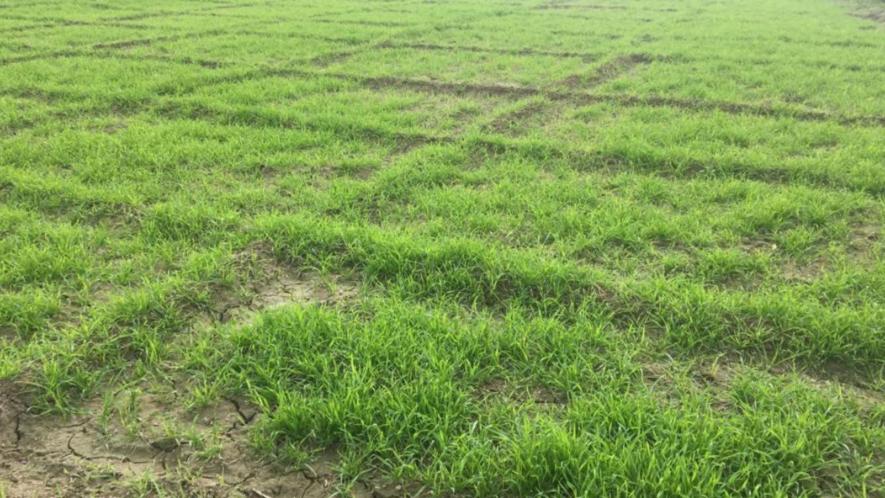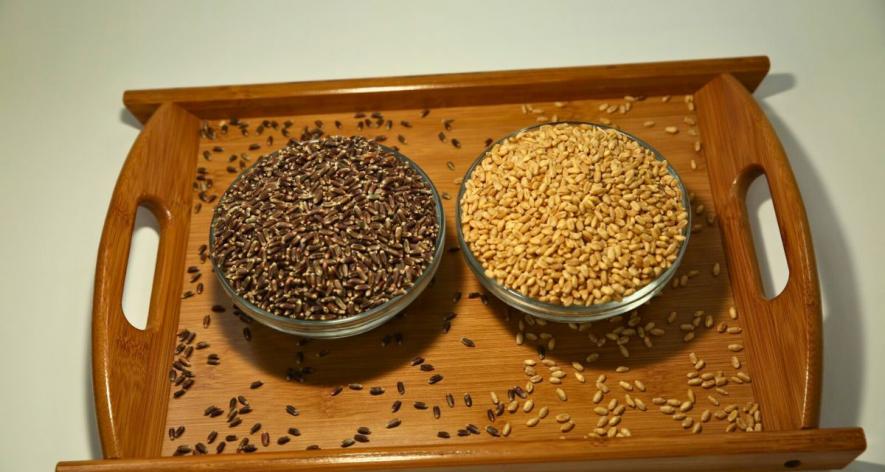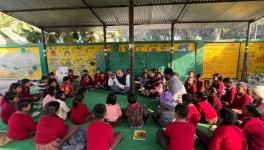Missing MSP, Awareness Keep Bio-fortified Black Wheat in the Dark

Black wheat growing in the farm (Photo sourced by Hiren Kumar Bose, 101Reporters)
Prayagraj, Uttar Pradesh: In 2018, Abhishek Srivastava (34) from Tandwa village in Uttar Pradesh's Shravasti acquired seeds of indigenously developed black-coloured wheat, NABI MG from the Mohali-based National Agri-Food Biotechnology Institute (NABI). After harvesting 20 quintals from an acre, he posted a video detailing its merits on social media platforms.
At a time when social media has become the go-to destination for those seeking information on emerging farm technologies, newly-introduced crops, and exotic vegetables and fruits, Srivastava was flooded with enquiries from farmers nationwide.
"I multiplied the F1 hybrid seeds on my farm. I sold 100 tonnes of black wheat seeds, including what I harvested and what I acquired from neighbouring farmers, in the last couple of years. Over 500 enterprising farmers from Uttar Pradesh, Rajasthan, Bihar, Haryana, Punjab, Madhya Pradesh, Maharashtra and Gujarat were the beneficiaries," claims Srivastava, president, Agri Junction, an Uttar Pradesh government initiative with 4,000 outlets across the state.
"I am told exporters have taken our black wheat even to Nepal, Pakistan and Afghanistan."
Black wheat is like ordinary wheat, but when ripe, its ears turn black. Its flour is greyish, similar to bajra (pearl millet) and unlike the regular off-white wheat. Interestingly, the grain has a longer shelf life. Its flour can be used to make food products made with whole wheat, such as breads, buns, biscuits, noodles, rotis, cakes and more. Despite its advantages, not all is well with this nutraceutical-rich grain, whose fame has been on the wane after the initial spike.
Benefits Aplenty
"It took us seven years of research and development to come up with NABI MG. This is a cross of the Japanese variety EC866732 with the high-yielding cultivar of wheat, PBW621. It is rich in anthocyanins, protein, dietary fibre, iron and zinc," Dr Monika Garg (49), NABI scientist and project head of black wheat, tells 101Reporters.
"The coloured wheat provides more benefits without the risk of high blood sugar."
A doctorate holder from Japan's Tottori University, Garg began working on the project in 2011 after NABI procured exotic genome plasma from Japan and the US before adapting them to India's environmental conditions through plant breeding. This is a method of changing the genetic pattern of plants, including through crossbreeding, to increase their utility for humans.

Dr Monica Garg (fourth from left in the first row) with NABL team which helped in developing black wheat (Photo sourced by Hiren Kumar Bose, 101Reporters).
According to Garg, a pioneer in black, purple and blue wheat research in India, the colour of fruits, vegetables, and grains becomes blue, purple or black due to an excess of anthocyanin, a natural antioxidant considered beneficial for health.
A high quantity of anthocyanin is usually found in jamun, blueberries and blackberries.
"In common wheat, anthocyanin content is only five ppm. But in black wheat, it is 100 to 200 ppm. There is a difference in the amount of zinc and iron, too. Black wheat contains 60% more iron than common wheat," says the Punjab-based plant breeder, who has scores of papers published about her work in research journals worldwide.
NABI scientists claim that black wheat can reduce the chances of cardiovascular diseases, diabetes and obesity. Bio-fortified with zinc, it can fight malnutrition among children, one of the health challenges in the country.
"The productivity of black wheat, a self-pollinated crop, is about 20 quintals per acre compared to 24 quintals of the high-yielding white variant. The size of black wheat seed is also smaller," says Garg. However, there is no difference in the agricultural practices adopted for normal and black varieties.
Initially, NABI transferred the expertise to 10 companies by signing memorandums of understanding with them. However, it did not go well. Presently, the institution sells its F1 hybrid seeds grown on 10 acres of its Mohali campus to farmers who ask for them.
Uttar Pradesh led the Way
In the last few years, villages in Prayagraj, Kaushambi, Pratapgad, Varanasi, Chandauli, Raebareli, and Gorakhpur have adopted black wheat cultivation. It slowly spread to almost all the districts in Uttar Pradesh.
Last October, agriculture department officials in Uttarkashi district initiated a pilot project for black wheat cultivation in 20 villages of Dunda and Naugaon blocks to increase farmers' income. Strangely, there is no policy in place from the Ministry of Agriculture or the Indian Council of Agricultural Research to encourage black wheat, which also translates into a lack of data regarding the acreage and the total number of households cultivating it. No incentive is given to farmers to grow this grain.
Among those who initially took to the charm of black wheat was Ravi Prakash Maurya (40), a career journalist. Having returned to his village in 2016 following his father's death, he has been cultivating black wheat from 2018 on one bigha in his farm at Mansoorpur in Prayagraj.
Maurya, who also cultivates black rice, black tomato, niger seeds, black turmeric and black potato, is a regular invitee to the agricultural fairs held in different districts of Uttar Pradesh. He was also felicitated by the Uttar Pradesh Agriculture Department for popularising black wheat.
"I am a regular black wheat grower and have so far sold 12 tonnes to farmers keen on growing it in Bundelkhand, Madhya Pradesh, Bihar, Delhi and West Bengal," he says.
"My household has totally given up regular wheat. We consume rotis, dalia, suji and cakes made from black wheat."
Like Maurya, Atul Singh Rajawat (35) of Urai village in Jalaun district has been growing black wheat on five bighas. His harvest has been around eight quintals per bigha. In the last five years, he sold 150 tonnes, having reached wannabe growers through Facebook and WhatsApp.
In Rajasthan, district-level award-winning farmer Kishan Singh (64) of Deoli village in Sirohi grows black wheat on two-and-a-half bighas. Ajay Singh (45) of Sikar district, who took to cultivating black wheat three years ago, gets a yield of 20 quintals from an acre. He has become a go-to seller after a YouTube channel featured him.
Dayaram Chaudhary (64) of Sandera in Tonk district eschewed chemical fertilisers such as DAP and urea to sow 40 kg of black wheat seeds in one acre. In return, he got a yield of 20 quintals. However, there is more to it than what meets the eye.
Disenchanted Growers
The interest in sowing black wheat is slowly waning among the farmers as stocks remain unsold. Kishan Singh has an unsold stock of 17 quintals from last year's harvest, while Dayaram Chaudhury had to launch a distress sale last year. Ravi Prakash Maurya has 15 tonnes of unsold stock in his home waiting for buyers. Normally, the price per quintal is between Rs 2,200 to 2,400, while the input cost is Rs 12,000 to 14,000/acre.
"In villages of Prayagraj, farmers have either stopped growing it or reduced its acreage. Similar is the case in other districts," says Indrajeet Gupta, who was recently the District Krishi Sahay Adhikari of Prayagraj and has now been transferred to Kaushambi.
"The sole reason is the lack of a market. No mandi [marketplace] accepts black wheat, mainly because the prospective consumer is unaware of such a product and its merits."
Only a handful of people market black wheat flour. Balkumari Agro Foods of Uttar Pradesh's Farrukhabad retails it under the brand name DR RBL's black wheat flour for Rs 250 a kg. Unwilling to share its sales figures, GC Katiyar of the brand informs, "Black wheat is not very popular due to a lack of awareness. However, the market is growing as the first-hand experience of its use is getting shared."

Showing comparison between black and white wheat (Photo sourced by Hiren Kumar Bose, 101Reporters) .
In such a scenario, a farmer from Maharashtra is showing the way ahead — focusing on the value-added products of black wheat rather than plain flour. For the last three years, Akshay Jagtap (28) of Kinjal village in Satara district has been encouraging farmers to grow black wheat by giving them seeds that he had acquired from a farmer in Indore.
"In Wai taluka, we have eight farmers who collectively grow black wheat on 10 acres. We buy the harvest, paying them an attractive rate. Our women's self-help groups make dalia, rawa and sewai, which we sell to the shops in Mahabaleshwar," says Jagtap.
Can an ecosystem be created for black wheat so that farmers continue to grow it and the community benefits from it?
"I would suggest that agricultural universities should be involved in popularising it. Food start-ups should be encouraged to invest in it, as has happened in the case of millet. Chefs should be onboard to develop recipes," Vinod Sharma, District Agriculture Officer, Raebareli, tells 101Reporters. "But most importantly, authorities need to fix the minimum support price of black wheat, introduce it in mid-day meals and distribute it through the public distribution system," he says.
(Hiren Kumar Bose is a Uttar Pradesh-based freelance journalist and a member of 101Reporters, a pan-India network of grassroots reporters.)
Get the latest reports & analysis with people's perspective on Protests, movements & deep analytical videos, discussions of the current affairs in your Telegram app. Subscribe to NewsClick's Telegram channel & get Real-Time updates on stories, as they get published on our website.
























